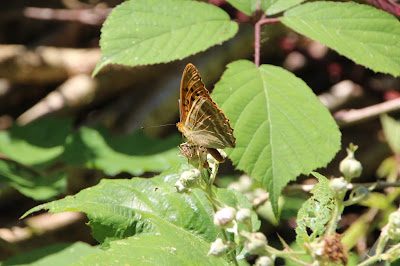6th July
We returned at 8pm, just to try the roost again as the wind was low and the planes should not have been overflying the lake. However, as it states on the website, there are times when runway use is not as planned and we had flights departing quite frequently.
We attracted a small contingent of hirundines inspite of the noise and four Reed Warblers provided us with something to do as we waited. We could see birds flying along the trees that line the lake edge and there were a few criss-crossing the lake. As always we were concerned about the party of Swallows overhead diverting to a quieter spot for an overnight stay at the last minute.
Birds had begun to make lazy circuits above the site so we moved closer in order to know as soon as any dived into the reeds close to our nets. We work with nothing more that headlamps so are sure to make best use of all natural light. It is rare for us to get catches in excess of 20 here, and although there is always the option to roost a big catch overnight and return to release them early next morning we prefer not to do this when possible as it never gets really dark here as another feature of the site is light pollution from the airport and surrounding roads.
We noticed a small group come in, from low over the lake, near the lake edge but didn't extract straight away as another six birds continued to circle quite low. However these soon roosted at a different spot and our catch turned out to be mainly Sand Martin. Obviously most of the Swallows had prefered the prospect of a quieter night.
Total: 14 (1)
Sand Martin - 7
Swallow - 2
Reed Warbler - 4
Blackcap - 1
Blue Tit - 0 (1)
7th July
We were back on site for 6am on a day that promised to see temperatures set to soar into the 30s. Our plan was to be packed up and away well before midday. In addition to the three nets in the reedbed we tried a new 3 panel net near the lake. Our usual 18m on the ramptrack had an additional 9m tagged on the end, right up to the edge of the newly excavated pit where we have seen so many birds cross behind the net. There was one more in weedy patch close to the Colne.
There was a marked contrast in the amount of bird activity along the soil heap banks to what we have seen in recent weeks and the track net had been catching well while we erected the last 12m. It hasn't happened for a while but we were quite busy with birds and breakfast had to wait until we'd made three rounds. There nineteen species! All the Songthrushes and Blackbirds came from the new 9m net. There was a good showing from the Reed Warblers, not all from the reedbed rides - some were caught in Chris' 3 panel 12m.
The Chiffchaff was interesting in that it had a bill deformation and two House Martins, both from my 9m 'extension' were a real bonus. We were off site by 11:15am.
3J Swallow
4M House Martin
Juvenile House Martin
4M Reed Bunting
Adult Chiffchaff with elongated bill
Total: 69 (7)
Swallow - 1
House Martin - 2
Dunnock - 3
Robin - 1
Blackbird - 4
Songthrush - 3 (1)
Sedge Warbler - 1
Reed Warbler - 14 (5)
Lesser Whitethroat - 2
Whitethroat - 5
Garden Warbler - 2
Blackcap - 18
Chiffchaff - 2
Blue Tit - 4
Great Tit - 2
Greenfinch - 1
Goldfinch - 3
Linnet - 1
Reed Bunting - 0 (1)
8th July
We put in a couple of hours at the end of the day, hoping to get some hirundines at roost. There were four new Reed Warblers and one retrap just before 21:00 and it was a little after that that a few Swallows dropped in. Ten Swallows were captured and ringed.
Total: 14 (1)
Swallow - 10
Reed Warbler - 4 (1)
9th July
The morning session was very much less busy than that conducted just two days before, but 46 birds was a reasonable tally with a few Blackcap, Whitethroat and Lesser Whitethroat as well as the expected Reed Warblers from by the lake.
Total: 39 (7)
Swallow - 1
Dunnock - 1
Robin - 1
Songthrush - 2
Reed Warbler - 11 (5)
Lesser Whitethroat - 2
Whitethroat - 8 (1)
Garden Warbler - 1
Blackcap - 7
Chiffchaff - 3 (1)
Goldfinch - 1
Linnet - 1
Additional observations included a Red Kite and three Hobby overhead.




















































